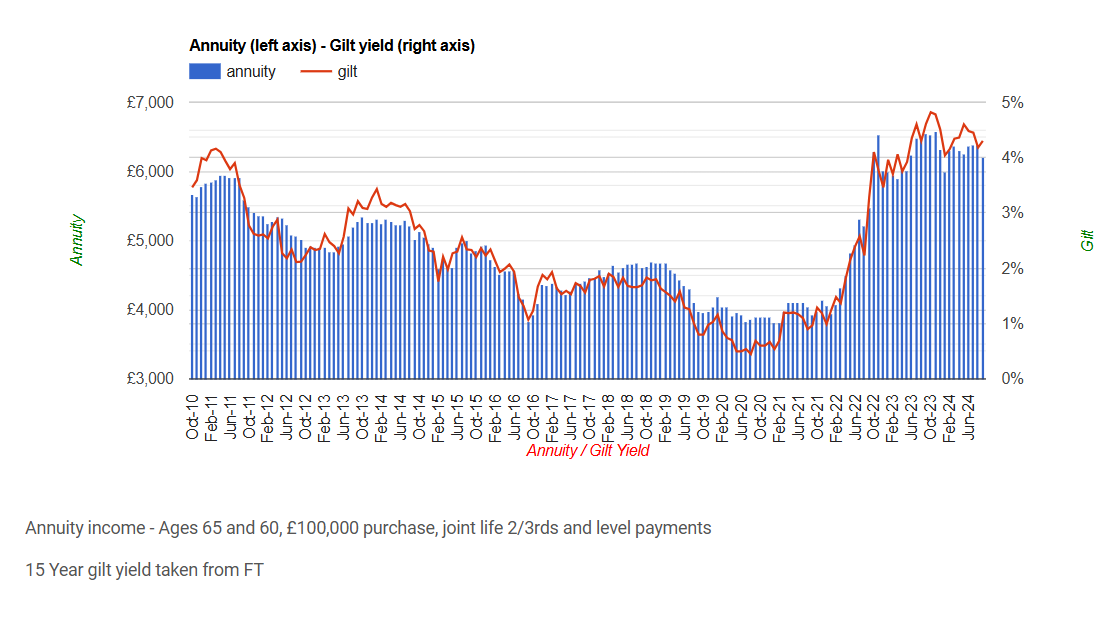Annuity Update Nov 2024
What next for annuity rates?
After the Bank of England cut interest rates again, does this signal the start of cuts to annuity rates?
The short answer is yes but the longer answer is that it depends on what happens in the bond markets.
As the chart below shows, annuity rates started to fall after the start of the credit crunch in 2008 and the downward spiral accelerated in 2011until the 2016 EU referendum vote when annuity rates to a fell to their lowest levels in living memory. Rates crashed again in 2020 before starting the increase to today’s high levels.
First it was the rise in inflation caused by the start of Russia’s illegal invasion of Ukraine which caused annuities to rise, then it was the infamous Liz Truss mini budget in September 2023 that turbocharged the rise in annuity rates.
Before the credit crunch in 2008, the benchmark annuity (£100,000 joint life annuity, 2/3rds spouse and level payments for ages 65 and 60) paid about £6,500 per annum gross. By 2016 it had fallen to about £3,800 and today, August 2024, it is paying nearly £6,400. This represents a 40% fall followed by an increase of the same amount.

The chart above plots the income from the benchmark annuity on the left axis and the yield on 15-year gilts and the UK bank rate on the right axis.
If the question is “will annuity rates now start to fall as interest rates start to fall”? The answer is probably yes, but I don’t expect rates to fall quickly or by big amounts.
I don’t expect annuity rates to crash in the same way they did after the credit crunch or the period up to 2020, rather a slow reduction of over time depending on yields.
As all good advisers will know, annuity rates are priced in relation to yields on long-dated fixed interest investments such as gilts and corporate bonds. This means the key to working out the long-term trends for annuities is to second guess the outlook for yields.
Just like equity markets, it is difficult, if not impossible to predict future for yields but it does seem that providing there are no unexpected financial or political shocks, inflation is being tamed and yields are likely to fall so we can expect the income from annuities to fall over time.
Although, annuity rates have probably peaked, I don’t think their role in retirement planning has peaked and providing rates do not crash to 2020 levels annuity sales will hold up and perhaps
increase for three and a half reasons. First, annuities remain the only way of delivering guaranteed income for life. The peace of mind and financial security provided by annuities must not be underestimated and should be contrasted to the risk and uncertainty of the alternatives such as pension drawdown.
Secondly, continued volatility in equity markets, it will remain difficult to take the same income from drawdown without taking undue risks. In many cases annuities are a hard to beat when the objective is to maximise income.
Finally, as the average age of people in drawdown increases the case for annuitising at older ages increases. It can be argued that in the past, the optimum age to arrange an annuity was between 60 and 65 but now the optimum age may be between 70 and 75. In practise, this means that as people travel along their own personal retirement journey the case for purchasing annuities gets stronger the older they get.
And the half reason? As advisers and their clients increase their knowledge and understanding about annuities and the important role they play in retirement planning the more likely they are to view annuities as a positive force for good as part of a combination of solutions rather just a policy for those with small pension funds or those who are risk adverse.
William Burrows
Founder of the Annuity Project and financial adviser with Eadon & Co
Help and advice
William Burrows will be pleased to answer your questions
About the author
William Burrows
William has been involved with retirement options for nearly 30 years, advising clients on all aspects of annuities and retirement income options.
He is a regulated adviser with Eadon & Co He has have many years of practical experience in advising clients about all aspects of pension options at retirement and he is passionate about helping people make the right decisions about their pensions and retirement income.
William also publishes guides including the popular ‘You and Your Pension Pot’ and ‘The Retirement Journey’.
He is frequently quoted in the national press and appears on radio, podcasts and videos and writes extensively on retirement income matters.